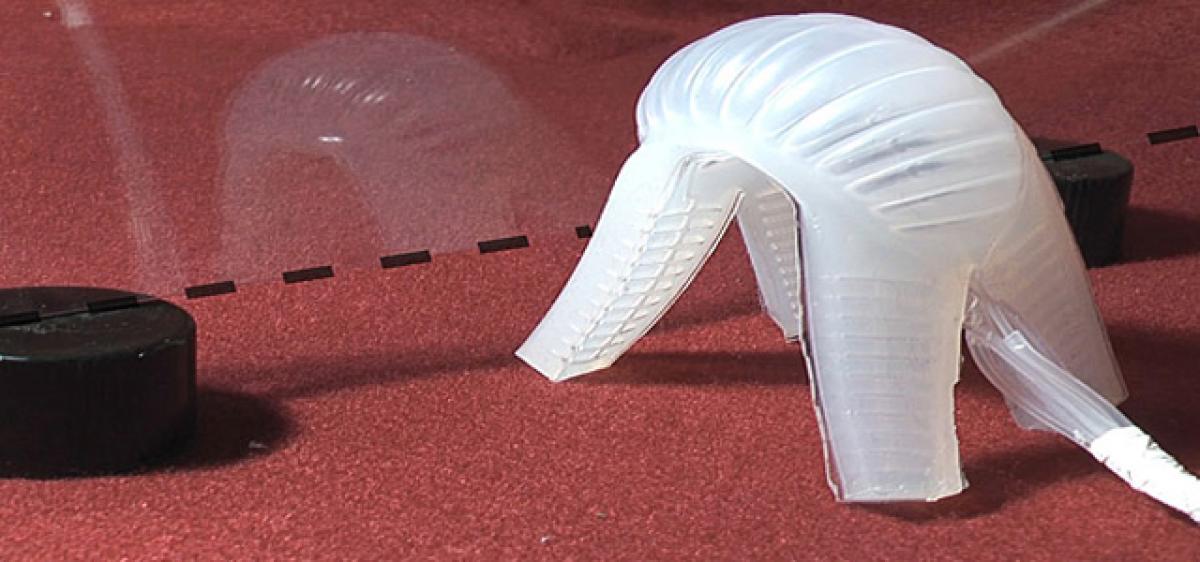Live
- Kailash Gahlot inducted into BJP’s Delhi election panel
- With state elections over, Indian stock market heads for stability
- Mahayuti's Ladki Bahin Brahmastra demolishes MVA in Maharashtra
- Actor and Youth Ambassador Darasing Khurana Highlights Mental Health Issues with Singapore PM
- Heavy FII selling in India to taper off soon, say market watchers
- Esports Mania Grips India: What are the Trends Fueling this Growth?
- AI-Powered CRM: Shaping the Future of Customer Relationship Management
- AI and Fraud Prevention in Pharmacy: Fayazoddin Mohamad’s Vision for a Safer Industry
- Google Gemini Prepares for a Smarter AI Era
- The Future of Healthcare: Bharath Kumar Kakkireni on Transforming Patient Care with Innovative Solutions
Just In

Scientists, including one of Indian origin, are developing soft, flexible robots that behave like human muscles and may help people with movement impairments, such stroke victims. The robots developed by researchers at EPFL (Ecole Polytechnique Federale de Lausanne) in Switzerland are made of low-cost materials and may easily be produced in large scale.
Geneva: Scientists, including one of Indian origin, are developing soft, flexible robots that behave like human muscles and may help people with movement impairments, such stroke victims.
The robots developed by researchers at EPFL (Ecole Polytechnique Federale de Lausanne) in Switzerland are made of low-cost materials and may easily be produced in large scale.
Soft robots, powered by muscle-like actuators, are designed to be used on the human body in order to help people move. They are made of elastomers, including silicon and rubber, and so they are inherently safe.
They are controlled by changing the air pressure in specially designed 'soft balloons', which also serve as the robot's body. Potential applications for these robots include patient rehabilitation, handling fragile objects, biomimetic systems and home care.
Researchers developed soft robots for medical purposes. One of their designs is a belt made of several inflatable components, which holds patients upright during rehabilitation exercises and guides their
movements.
"We are working with physical therapists from the University Hospital of Lausanne (CHUV) who are treating stroke victims," said Matthew Robertson, the researcher in charge of the project.
"The belt is designed to support the patient's torso and restore some of the person's motor sensitivity," said Robertson.
The belt's soft actuators are made of pink rubber and transparent fishing line. The placement of the fishing line guides the modules' deformation very precisely when air is injected.
"For now, the belt is hooked up to a system of external pumps. The next step will be to miniaturise this system and put it directly on the belt," said Robertson.
Researchers showed that their model could accurately predict how a series of modules – composed of compartments and sandwiched chambers – moves.
The cucumber-shaped actuators can stretch up to around five or six times their normal length and bend in two directions, depending on the model.
"We conducted numerous simulations and developed a model for predicting how the actuators deform as a function of their shape, thickness and the materials they're made of," said Gunjan Agarwal, from EPFL.
One of the variants consists of covering the actuator in a thick paper shell made by origami. This test showed that different materials could be used. The researchers are also using soft actuators to develop adaptable robots that are capable of navigating around in cramped, hostile environments.
"Using soft actuators, we can come up with robots of various shapes that can move around in diverse environments," said Jamie Paik, EPFL's Reconfigurable Robotics Lab (RRL).
"They are made of inexpensive materials, and so they could easily be produced on a large scale. This will open new doors in the field of robotics," Paik said.

© 2024 Hyderabad Media House Limited/The Hans India. All rights reserved. Powered by hocalwire.com







